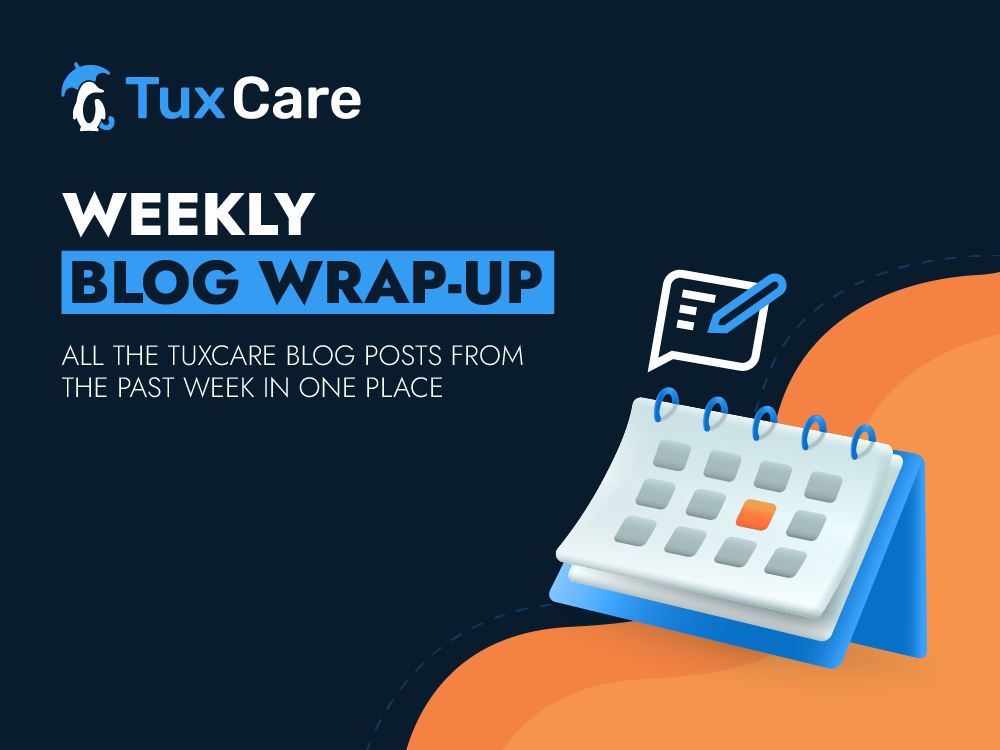Weekly Blog Wrap-Up (May 15-19, 2023)
Welcome to the TuxCare Weekly Blog Wrap-Up – your go-to resource for the latest insights on cybersecurity strategy, Linux security, and how to simplify the way your organization protects its data and customers.
At TuxCare, we understand the importance of safeguarding your valuable data and ensuring the smooth operation of your Linux infrastructure. That’s why our team of Linux and open-source experts is dedicated to providing you with the most up-to-date information, Linux tips, and patch management solutions.
In each edition of our Weekly Blog Wrap-Up, you’ll get a short breakdown of all our informative and thought-provoking blog posts from the past week. Whether you’re seeking expert insights into Linux security best practices, practical tips to optimize your system performance, or comprehensive strategies to streamline patch management, you’ll find it all here!
We believe that knowledge is key to staying one step ahead in the ever-evolving world of Linux security, and our goal is to empower your organization with the tools and expertise needed to strengthen your Linux environment.
Feel free to click on the following blog post summaries to read each post in its entirety:
How to Migrate AlmaLinux 8 to 9 Using ELevate 
Discover how to migrate from AlmaLinux 8 to 9 using the ELevate tool, which automates the upgrade process and ensures a smooth transition. By upgrading to AlmaLinux 9, users can receive support and security updates until 2027 and 2030, respectively. In this blog post, you’ll also find out why enterprises should consider Enterprise Support for Almalinux, as it extends support for up to 16 years + break-and-fix support, extended security updates with continuous FIPS compliance and non-disruptive patching and pay-as-you-go hourly support bundles.
5 Cybersecurity Weaknesses Critical Infrastructure Owners Should Guard Against 
Critical infrastructure, such as electricity distribution and telecoms, faces frequent attacks due to its vital role in various aspects of everyday life. Plus, the unique weaknesses found in the hardware and software supporting critical infrastructure make it an attractive target for hackers. This blog post explores five vulnerabilities that infrastructure operators should be mindful of, and how they can keep their environments safe with a modernized approach to vulnerability management.
How Live Patching Can Help Manage Vulnerabilities 
This blog post covers the benefits of live patching, such as reducing manual intervention, minimizing the risk of downtime, and promptly applying patches. By adopting live patching, organizations can automate and simplify vulnerability patching while ensuring system security and stability. By reading this blog, you’ll also discover more about KernelCare Enterprise, TuxCare’ popular live patching solution, and its process of monitoring vulnerabilities, creating and distributing patches, and seamlessly applying them to the running kernel without requiring downtime or disruptions.
Adopting DevSecOps: Integrating Security into Your Daily Operations 
DevSecOps is a security-focused approach that integrates security into every stage of the software development lifecycle. This blog post emphasizes the need for DevSecOps and explains its key concepts, such as shifting security left and fostering collaboration between teams. By reading this blog post, you’ll understand the pillars of DevSecOps and what lies in the future of DevSecOps, including the role of AI and machine learning, and as well as the importance of planning and adapting to emerging trends in the field.



 Documentation
Documentation Login
Login



